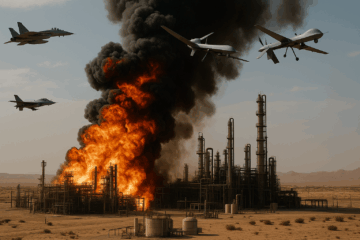In November 2021, Russia launched an anti-satellite (ASAT) missile test that destroyed one of its own defunct satellites. This act generated thousands of pieces of space debris. It also underscored a growing reality; space is no longer a sanctuary but a contested warfighting domain. As adversaries such as China and Russia develop counterspace capabilities, the United States must strengthen its space deterrence strategy to ensure security, stability, and freedom of operation in orbit.
The challenge is clear; adversaries are developing ASAT weapons, electronic warfare capabilities, and cyber threats that can disable American satellites—disrupting military operations, global communications, and economic stability. Without a robust deterrence framework, adversaries are emboldened to target space infrastructure. To counter these threats, the US must enhance resilient space architectures, strengthen policy frameworks, and refine operational doctrine to deter and, if necessary, defeat adversarial actions in space.
Resilient Space Architectures: Hardening the Backbone of American Space Operations
One of the most effective deterrence measures is making space assets more difficult to target and replaceable, if attacked. The United States is shifting from large, centralized satellite systems to disaggregated and proliferated constellations, reducing the risk posed by any single point of failure. The Proliferated Warfighter Space Architecture (PWSA), led by the Space Development Agency, aims to deploy a network of small, low-cost satellites that provide redundancy, making it harder for adversaries to cripple American space capabilities with a single strike.
Additionally, on-orbit servicing, maneuverable satellites, and rapid launch capabilities enhance resilience. SpaceX’s Starlink and the Rapid Agile Launch Initiative ensure that the US can quickly replenish space assets, denying adversaries the ability to achieve lasting effects through space attacks. By maintaining a dynamic, self-healing space architecture, the US strengthens deterrence by signaling that any attempted disruption will be ineffective.
Counterspace Capabilities: Strengthening Active and Passive Defenses
While resilience is key, deterrence also requires credible counterspace capabilities to impose costs on adversaries. The US Space Force and other defense agencies are investing in defensive counterspace measures, such as jamming-resistant communications, maneuverable satellites, and cyber-hardened space systems to protect critical assets.
At the same time, the US must maintain offensive counterspace capabilities as part of a deterrence posture. This includes electronic warfare tools to disrupt enemy satellite operations, rendezvous and proximity operations (RPO) for on-orbit inspection and intervention, and ground-based kinetic and non-kinetic capabilities to neutralize hostile space threats. By demonstrating both defensive resilience and credible response options, the US reinforces deterrence by denial and punishment.
Policy and Alliances: Strengthening Space Norms and Collective Security
A strong policy framework and allied cooperation bolster deterrence by shaping adversary behavior and reinforcing international stability. The Artemis Accords, a multinational agreement on responsible space conduct, establish norms that promote transparency and discourage hostile activities. The US must continue leading diplomatic efforts to build consensus on space security standards, making aggressive actions politically and strategically costly for adversaries.
Additionally, alliances like the North Atlantic Treaty Organization (NATO), partnership with the Quad (Australia, India, Japan, and the US), and Five Eyes intelligence network provide collective security in space. The Combined Space Operations (CSpO) initiative, which includes Australia, Canada, France, Germany, New Zealand, the UK, and the US, enhances shared situational awareness and rapid coordination in space crisis scenarios. By integrating allied capabilities, the US deters adversaries by presenting a unified, multinational response to any hostile space activity.
Space Domain Awareness: Gaining the Tactical Advantage
Deterrence depends on knowing when and where threats emerge. The US Space Force and the National Reconnaissance Office (NRO) are advancing Space Domain Awareness (SDA) through advanced radar systems, AI-powered surveillance, and persistent monitoring of space objects. Programs like the Deep Space Advanced Radar Concept (DARC) and the Space Surveillance Telescope provide real-time tracking of adversary satellite maneuvers, ensuring that hostile actions do not go undetected.
By integrating AI and machine learning, the US can predict and respond to potential threats before they escalate. Improved SDA capabilities deny adversaries the element of surprise, reinforcing deterrence by ensuring that any aggressive move is immediately identified and countered.
Military Space Operations: Defining Rules of Engagement
To deter and defeat adversary actions, the US must develop clear space warfighting doctrine and operational concepts. The Space Force’s “competitive endurance” strategy emphasizes continuous engagement with adversaries to counter gray zone tactics, such as cyber intrusions, satellite blinding, and electromagnetic interference. Establishing clear rules of engagement for responding to hostile actions in space strengthens deterrence by ensuring decisive and proportional responses when necessary.
Additionally, the integration of space with multi-domain operations ensures that any adversary attack on space assets is met with cross-domain retaliation, whether in cyber, air, land, or sea. This raises the stakes for adversaries, reinforcing deterrence by making space conflict an unattractive option.
Conclusion: A Comprehensive Approach to Space Deterrence
The US must pursue a multi-layered strategy to deter and defeat adversary actions in space. Resilient architectures, credible counterspace capabilities, strong alliances, superior space domain awareness, and well-defined military operations are essential to ensuring freedom of action in space and securing national security interests. As space becomes increasingly contested, the ability to deter, detect, and defeat threats will determine whether the US maintains its strategic advantage beyond the atmosphere.
Brandon Toliver, PhD, is an engineer and career civil servant with the Department of the Air Force. The views expressed are his own and do not necessarily represent those of the US Air Force. Views expressed in this article are the author’s own.





Great read! The shift from big, clunky satellites to small, replaceable ones feels like a no-brainer in this contested era. But I’m curious—how do we keep all those new satellites from creating a space junk problem?
In a peer to peer conflict, it appears inevitable that satellites and space assets will experience something akin to observation balloons a hundred plus years ago, better prepare now for the dawn patrol.
Excellent article on such an important topic! It’ll be interesting to see how the US incorporates advanced AI & Machine Learning systems into detection strategy. I’m particularly interested to see the development of prediction capabilities.